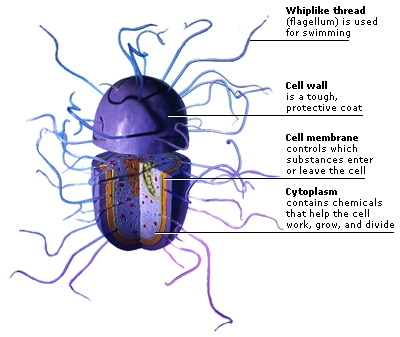DK Science: Bacteria
Bacteria are monerans, the simplest single-celled organisms. They are the smallest of all cells, visible only through powerful microscopes. Bacteria are also the most abundant forms of life. They live in the air, on land, in water, and even inside the bodies of animals and plants. Some bacteria cause diseases, but others are useful. Bacteria recycle nutrients in the soil and aid the human digestive system.

Most bacteria are surrounded by a tough cell wall. Inside, the genetic material is not contained in a nucleus, but is free in the cytoplasm. Some bacteria have fine hairs that enable them to stick to surfaces. Others have miniature tails that help them to swim.
Without bacteria, other life on Earth could not survive. Bacteria in the soil release nitrates, a usable form of the element nitrogen. All plants need nitrates to make vital chemicals called amino acids. Pea and bean plants, such as soybeans, use bacteria called Rhizobium which convert nitrogen straight into amino acids. The bacteria live on the plants’ roots in swellings called root nodules.
Pasteur was a chemist who showed that food decays because of microorganisms, such as bacteria. He found that heat treatment killed these microbes. This process, pasteurization, is still used to preserve foods. Pasteur also showed how bacteria can cause disease and developed the use of vaccines to control them.
